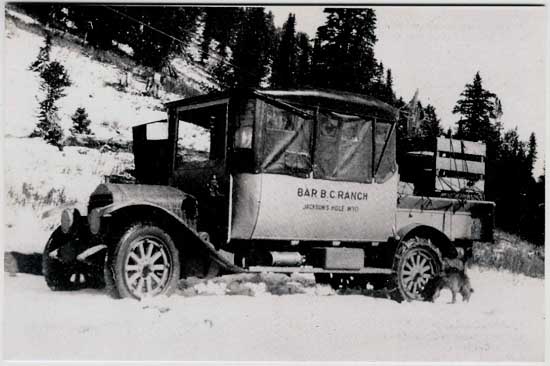
Bar B C Dude Ranch
Prior to the establishment of the Bar B C, Jackson Hole was known only to a few sportsmen. The Bar B C brought
attention to the valley. Burt was well established in Philadelphia and thus, especially after the sinking of the Royal Mail Ship LUsitania, vacations in the
West rather than in the United Kingdom became more popular with the well-to-do. Burt brought additional attention to the
valley with his 1924 Diary of a Dude Wrangler in which he noted:
Some of the happiest hours I have ever spent and some of the most
profitable, philosophically speaking, have been spent on the top rail of a
corral fence, the favorite sitting-place of all Westerners if they have
nothing else to do* * *
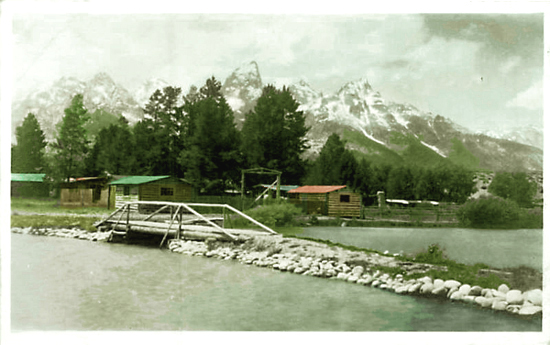
Bar B C Ranch, undated.
To a great extent Burt and his ranch established Jackson Hole and the Tetons as a destination for the
rich and famous. Among those who worked on the ranch was Elliott Roosevelt, son of the Governor of New York,
Franklin D. Roosevelt. The ranch made a deliberate attempt to look rustic with its red and green roll roofing. Nevertheless,
it was to a great extent "snooty" provding masquerade balls for its guests. At least one guest brought her French maid
with her. In advertisements the ranch required that guests provide references. It had housing in various
cabins sufficient to house fifty dudes.
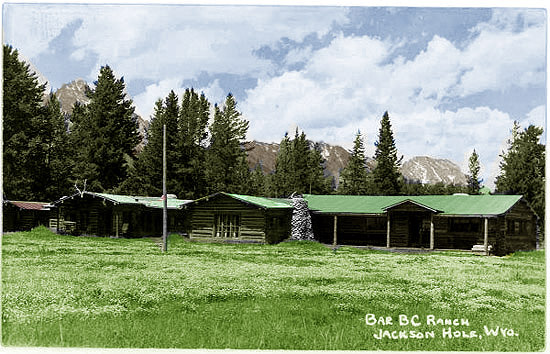
Bar B C Dude Ranch, undated.
Burt was sensative to the use of the word "dude" to describe his clientele and his facility. In
the Diary of a Dude Wrangler, he argued that the word "dude" "has none of the slurring
connotations attached to the term tenderfoot. It does not imply ignorance or softness, it simply means some one, usually a
person not resident in the country who hires some one else to guide him or cook for him, or
who pays money to stay on a ranch." To overcome the ignominy that the Bar B C was not a
"real" ranch, he added cattle.
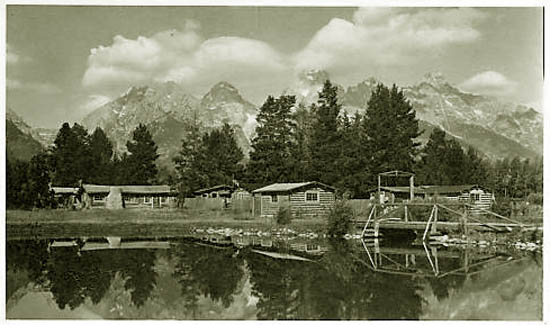
Bar B C Dude Ranch, undated.
Others may have had a different view of dudes. In 1926, Burt argued in Scribner's Magazine that Wyoming was
anti-prohibition, that the state was "wet." The Cheyenne Tribune responded that his observation after a three-year resdience abroad,
"was prejudiced by his environment -- a 'dude ranch' the clientele of which is chiefly 'wet' Easterners."
Burt expanded his operations. He established the White Grass Ranch for Boys and the "Lower Bar B C." With the demise, as discussed below
of the original Bar B C, the Lower ranch has been converted into a residential land development now known as
the "Bar B. C."
In 1919, Horace Albright, superintendent of the Yellowstone National Park, began suggestions for the designation of the Grand Tetons as a
national park. When he visited Jackson with his proposal, however, he was "practically run out of town."
Albright was not, however, the first superintendent to propose protection for the
area. As early as the 1890's Acting Yellowstone Superintendent Col. S. B. M. Young proposed expanding Yellowstone Park into
Jackson Hole.
Not learning from his experience in Jackson, in 1923, Albright met with several dude ranchers and Moran ferry owner,
Maud Noble. While all agreed that the Grand Tetons needed protection, only Albright was
in favor of national park status.
In 1924 Albright met with John D. Rockefeller, Jr. In
September, 1926, Albright escorted John D. Rockefeller, Jr. down the Snake past the
Grand Tetons and past Jackson. Rockefeller, at age 12, had previously visited Yellowstone with his parents in
1886.
Albright with Rockefeller formulated a secret and perhap somewhat deceptive plan relating to the valley. The elements of the
plan as outlined in a letter from Horace M. Albright to Rockefeller, dated February 16, 1927:
1. "Nothing would be said, "at the present time of acquiring all of
the private holdings in the Jackson Hole.
2. The acquisition would be coordinated with the efforts of Maxwell Struthers Burt, propietor of the
Bar B C Dude Ranch and
Henry Stewart, propriator of the J Y Dude Ranch.
3. The acquisition would be through the guise of a recreation or hunting club or a cattle company.
4. The region would be turned back to
nature. Cattle grazing rights would be "extinquished," with, perhaps, one ranch kept "as a sort of
museum exhibit."
On Febrary 28, 1927, Rockefeller approved the plan. See Worthwile Places, Correspondence of John D. Rockefeller, Jr. and
Horace M. Albright edited by Jospeh W. Ernst, Rockefeller University, 1991.
There was one important exception to the plan to acquire all private interests in the valley.
In a letter dated Sept. 22, 1919, to Congressman
Frank Mondell, Burt had bitterly opposed Albright's plans for turning the valley into a park. He contended that the only
reason was to enrich concessionaires in Yellowstone National Park, it would, "very effectively ruin this country for all but the stockholders of the
transportation company,' he wrote.
But as indicated, Burt was turned around by the Rockefeller interests and Burt is generally given credit for having supported the National Park status for the valley and having assisted in
Rockefeller's effort. The approval given by Rockefeller excepted out lands held by "Friendly Dude Ranchers." One of the friendly dude ranchers was, of
course, Burt who, with his partner was allowed to sell the ranch to Rockerfeller but retain a life estate. Thus, the
Bar B C continued in operation for the next fifty years. In essence, the Bar B C would have a near monopoly particularly if the
Elbow could be eliminated. Stewart's J. Y. was purchased by the Rockefellers.
Rockefeller established the
Snake River Land Company as a cover to hide his interest. The company, based out of Salt Lake City,
began buying property in the area. Not withstanding the cover, the company ran into
opposition with persons believing that it was a cover for the Church. Nevertheless, Rockefeller acquired some 35,310 acres including the
area on Antelope Flats which had been homesteaded by the Mormons and others. In 1929, the Park
was established. In areas in which the Park Service obtained control, it adopted a policy of allowing the area regardless of the
historic nature of the structures to revert to nature.
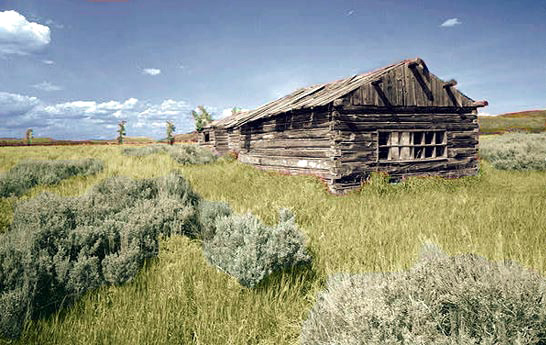
Joe Pfeiffer Homestead, Antelope Flats, 1970's.
Among the properties acquired by Rockefeller was the Joe Pfeiffer homestead.
Pheiffer had been a copper miner in Butte. He built his homestead in 1910. With irrigation and
hard work, the homesteads moved from sage brush to pasture and hay fields. With the acquisition of property in the valley, many of the
homesteads sat forlorn and abandoned. The homesteads quickly reverted from pasture to sage brush.
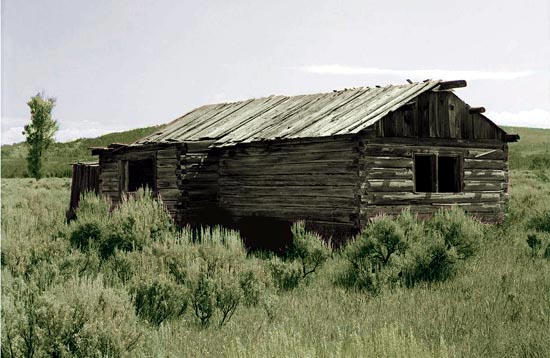
Woodshed, Pfeiffer Homestead, Antelope Flats, 1970's.
In summertime the valley becomes dryer increasing the danger of brush fires. The driest months are July and August. At the same time in the
late afternoon and early evening, the reverberation off the mountains of thunder signals on the onset of a coming
"dry" thunderstorm. . At night, one counts the seconds from the flash until one hears the rumble telling how far away
the storm is. Large parts of the
1988 Yellowstone Fires were caused by dry lighning. On a Sunday afternoon in August 1994, one such storm crossed over
Antelope Flats. The sage which had been growing for some forty years was breast high. As depicted in the
above photos, the sage grew right up to the Pfeiffer buildings and
provided an ideal fodder for brush fires. A lightning bolt, unaccompanied by
rain, ignited the dry sage. Pfeiffer's previous homestead was swiftly consumed by the advancing flames.
Firefighters were able to save houses along Mormon Row.
In 1937 Burt sold his interest in the Bar B C.
In 1968 the life estate ended and the Park Service obtained
control of the ranch. Stewart's J. Y. was purchased by the Rockefellers. The National Park Service did not forget the original plan to
return the area to nature. The Bar B C was allowed to go to rack and ruin.
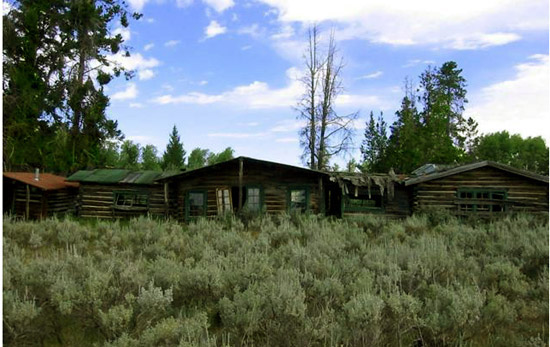
Bar B C main cabin reverting to nature.
Many of the cabins of the Bar B C still remain in a condition of ruin. For those wishing to
visit the remains, a four-wheel drive vehicle is recommended.
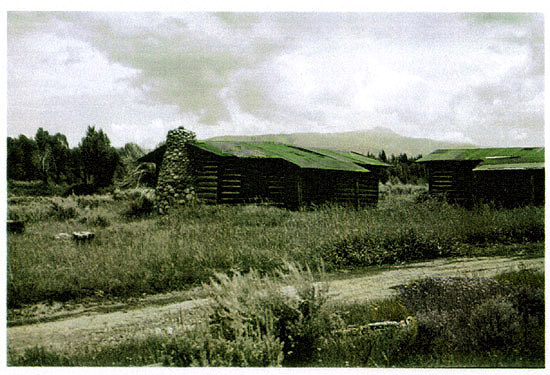
Ruins of Cabins at the Bar B C.
Do not attempt to enter the structurs as their condition is dangerous.
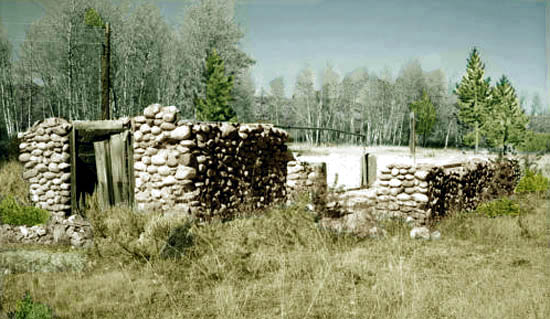
Woodshed, Ruins of the Bar B C bathhouse.
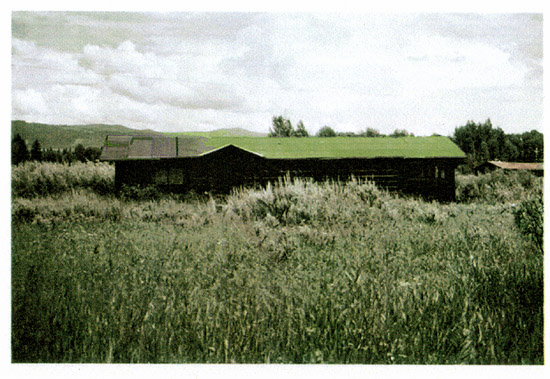
Ruin of Cabin at the Bar B C.
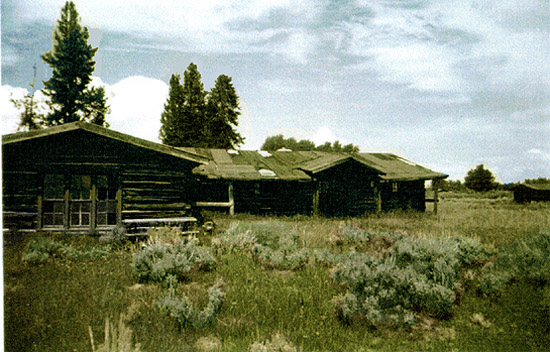
Ruins of Cabins at the Bar B C.
For discussion of the origin of dude ranching in
the West, see Eaton Brothers.
Next page: The Gros Ventre Landslide, the Kelly flood.